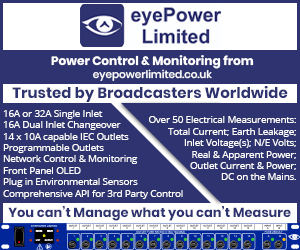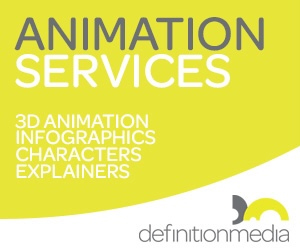Broadcast News
22/04/2013
Arguments For And Against 4K - Part Two
There are serious technical challenges for shooting and delivering in 4K.
Firstly, the file sizes are enormous - 8.6m pixels in a frame; at 16bit colour depth, means 1.7TB/hour! This is HUGE!
An example of this was given recently by Nicholas Recagno who provided technical support for the final online of The Hobbit. The final online master at 48 fps, stereoscopic 3D of uncompressed 16 bit 4K files required 2.2GB/second of data – this is 2x faster than a fully loaded RAID drive equipped with thunderbolt can deliver… It really is at the limit of what current computing technology can provide.
Plus you have to find a way to archive this data. The current LTO6 backup tape format only has a lifetime 25 years and therefore needs to be copied to new media every 3rd hardware generation, so this is a very important consideration, as there is no helpful HDCAM SR system at present which can capture and archive these files in true 4K yet.
So if we acknowledge the need to compress images, which will by definition be a ‘lossy’ form of compression, then isn’t there an argument that it might be better to record a lower rate of compression but in 2K/HD perhaps? Especially if you had at your disposal a way of capturing images at 48P instead of just 24P? HDCAM SR and existing technology can cope with this now in full uncompressed format without spending any extra in expensive infrastructure…
And then how do you view 4K?
Firstly, you need a lot of money for ah HD TV set. Until Sony released sets in April 2013 for $5,000, you needed $40,000 for an 86" UHD TV and the larger sets are still the price of an executive car! OK, the prices will come down in time but having spent such a vast sum on a screen, how can you ensure that you will see the images properly?
There was a study some years ago in the US, which found that most people sit too far from their TVs – the average distance was 9ft. Under optimal view conditions for 20/20 vision, the optimal viewing distance has been calculated to be 1.8x the width of the screen, so 9ft distance is required for a 70" diagonal to distinguish detail for UHD. Displays are becoming bigger and this is the basic argument for 4K but houses are not – especially in the UK!
But where does the 4K content come from? The gigantic files are way beyond the capability of internet presently and we will require more bandwidth for terrestrial, cable or satellite, whichever is the designated vehicle for 4K transmission. First, we will require a new compression standard to be universally adopted and the present H.264 will become H.265, though this will take years to adopt and will still give a large level of compression too.
Blu-ray disks are possible but a 2K film currently uses all 50GB, so a 4K film would need a 3rd and a 4th layer to shoehorn a 4K film onto a Blu-ray disk and the technology isn’t here to achieve this… yet.
Finally, all cabling for the "last mile" to all houses would need to be replaced in order to work for 4K images, not to mention a complete replacement of all equipment in the production and post production process to be able to edit, route, post produce, copy, archive 4K images…
"It’s about orchestrating a seismic shift in the broadcast and entertainment infrastructure, not to mention rewriting the consumer electronics handbook" according to Techradar.
Additionally, who is going foot the bill to do this infrastructure replacement in these cash-strapped times?
4K will come though, so if we acknowledge this, just how long will it take to penetrate to the mass consumer?
The best guide is the penetration of HDTV. The first American nationwide broadcast of an HD programme was John Glenn’s lift-off in the Space Shuttle in 1998. It took another 12 years for HDTV to go mainstream; so by that reckoning it should be 2025 before UHD 4K is in half of all American homes.
4K may be the future but there are some very steep technical requirements.
www.vmi.tv
(JP/CD)
Firstly, the file sizes are enormous - 8.6m pixels in a frame; at 16bit colour depth, means 1.7TB/hour! This is HUGE!
An example of this was given recently by Nicholas Recagno who provided technical support for the final online of The Hobbit. The final online master at 48 fps, stereoscopic 3D of uncompressed 16 bit 4K files required 2.2GB/second of data – this is 2x faster than a fully loaded RAID drive equipped with thunderbolt can deliver… It really is at the limit of what current computing technology can provide.
Plus you have to find a way to archive this data. The current LTO6 backup tape format only has a lifetime 25 years and therefore needs to be copied to new media every 3rd hardware generation, so this is a very important consideration, as there is no helpful HDCAM SR system at present which can capture and archive these files in true 4K yet.
So if we acknowledge the need to compress images, which will by definition be a ‘lossy’ form of compression, then isn’t there an argument that it might be better to record a lower rate of compression but in 2K/HD perhaps? Especially if you had at your disposal a way of capturing images at 48P instead of just 24P? HDCAM SR and existing technology can cope with this now in full uncompressed format without spending any extra in expensive infrastructure…
And then how do you view 4K?
Firstly, you need a lot of money for ah HD TV set. Until Sony released sets in April 2013 for $5,000, you needed $40,000 for an 86" UHD TV and the larger sets are still the price of an executive car! OK, the prices will come down in time but having spent such a vast sum on a screen, how can you ensure that you will see the images properly?
There was a study some years ago in the US, which found that most people sit too far from their TVs – the average distance was 9ft. Under optimal view conditions for 20/20 vision, the optimal viewing distance has been calculated to be 1.8x the width of the screen, so 9ft distance is required for a 70" diagonal to distinguish detail for UHD. Displays are becoming bigger and this is the basic argument for 4K but houses are not – especially in the UK!
But where does the 4K content come from? The gigantic files are way beyond the capability of internet presently and we will require more bandwidth for terrestrial, cable or satellite, whichever is the designated vehicle for 4K transmission. First, we will require a new compression standard to be universally adopted and the present H.264 will become H.265, though this will take years to adopt and will still give a large level of compression too.
Blu-ray disks are possible but a 2K film currently uses all 50GB, so a 4K film would need a 3rd and a 4th layer to shoehorn a 4K film onto a Blu-ray disk and the technology isn’t here to achieve this… yet.
Finally, all cabling for the "last mile" to all houses would need to be replaced in order to work for 4K images, not to mention a complete replacement of all equipment in the production and post production process to be able to edit, route, post produce, copy, archive 4K images…
"It’s about orchestrating a seismic shift in the broadcast and entertainment infrastructure, not to mention rewriting the consumer electronics handbook" according to Techradar.
Additionally, who is going foot the bill to do this infrastructure replacement in these cash-strapped times?
4K will come though, so if we acknowledge this, just how long will it take to penetrate to the mass consumer?
The best guide is the penetration of HDTV. The first American nationwide broadcast of an HD programme was John Glenn’s lift-off in the Space Shuttle in 1998. It took another 12 years for HDTV to go mainstream; so by that reckoning it should be 2025 before UHD 4K is in half of all American homes.
4K may be the future but there are some very steep technical requirements.
- If higher resolution is the goal, then shoot at higher frame rate, which will achieve this at lower cost.
- At best the benefits of 4K are subtle on existing display equipment.
- Also there are clear disadvantages to 4K – not least of which is the extra cost of moving around and processing the massive amounts of data that 4K involves.
- I would like to finish on a case study of a theatrical feature shot with VMI's cameras in 4K. 'Fast Girls' was shot at 4K on the RED EPIC however the film was never finished in 4K because of the cost. The film went to theatrical release and it still looked fantastic despite not having been finished as intended.
www.vmi.tv
(JP/CD)
Top Related Stories
Click here for the latest broadcast news stories.
07/06/2023
Brainstorm Celebrates 30 Years In Business
Brainstorm is celebrating 30 years in business at Broadcast Asia. The firm is exhibiting in Singapore, from 6 to 9 June. Brainstorm underlines how a c
Brainstorm Celebrates 30 Years In Business
Brainstorm is celebrating 30 years in business at Broadcast Asia. The firm is exhibiting in Singapore, from 6 to 9 June. Brainstorm underlines how a c
05/04/2023
Brainstorm Celebrates 30 Successful Years In Business
Brainstorm is to exhibit at the NAB Show for the 25th time. Brainstorm is proud of this commitment with the industry that underlines how a company foc
Brainstorm Celebrates 30 Successful Years In Business
Brainstorm is to exhibit at the NAB Show for the 25th time. Brainstorm is proud of this commitment with the industry that underlines how a company foc
04/04/2023
VITEC Celebrates 35 Successful Years
VITEC is joining the NAB 2023 Centenary celebrations by marking its own 35 year anniversary milestone. Since 1988, VITEC has been a pioneer of innovat
VITEC Celebrates 35 Successful Years
VITEC is joining the NAB 2023 Centenary celebrations by marking its own 35 year anniversary milestone. Since 1988, VITEC has been a pioneer of innovat
19/04/2023
EVS Launches Neuron View
EVS has launched Neuron View, a flexible, low-latency and power-efficient multiviewer, specifically designed to support the needs of live production t
EVS Launches Neuron View
EVS has launched Neuron View, a flexible, low-latency and power-efficient multiviewer, specifically designed to support the needs of live production t
04/04/2014
Sony And FIFA To Collaborate On A Range Of 4K Initiatives
Sony and FIFA (Fédération Internationale de Football Association) have announced they will collaborate on a range of 4K initiatives at the 2014 FIFA W
Sony And FIFA To Collaborate On A Range Of 4K Initiatives
Sony and FIFA (Fédération Internationale de Football Association) have announced they will collaborate on a range of 4K initiatives at the 2014 FIFA W
11/07/2023
Fabstir Unveils Vision To Democratise Film And Media Market
Fabstir, a groundbreaking platform leveraging Web3 technologies, has announced a vision to transform the film and media industry by democratizing the
Fabstir Unveils Vision To Democratise Film And Media Market
Fabstir, a groundbreaking platform leveraging Web3 technologies, has announced a vision to transform the film and media industry by democratizing the
10/07/2023
Brompton Technology Helps Cyans LED Virtual Studio Transform Taiwan'sTV And Film Production Industry
Harvatek, a Taiwanese supplier of LEDs, has partnered with an experienced local equipment distributor to establish a joint subsidiary called Cyans Vis
Brompton Technology Helps Cyans LED Virtual Studio Transform Taiwan'sTV And Film Production Industry
Harvatek, a Taiwanese supplier of LEDs, has partnered with an experienced local equipment distributor to establish a joint subsidiary called Cyans Vis
09/06/2014
4K OK? Understanding UltraHD... (Pt 2)
"The latest workstations and professional laptops are now up to the task of 4K content creation and NLE developers are all beginning to support native
4K OK? Understanding UltraHD... (Pt 2)
"The latest workstations and professional laptops are now up to the task of 4K content creation and NLE developers are all beginning to support native
13/10/2023
Avid Joins Roybal School of Film and Television Production Magnet
Avid is continuing its mission to help more people gain skills for successful careers in the entertainment industry as the first technology Founding P
Avid Joins Roybal School of Film and Television Production Magnet
Avid is continuing its mission to help more people gain skills for successful careers in the entertainment industry as the first technology Founding P
03/10/2023
BBC Film Helps Support UK Producers
BBC Film has announced two new opportunities to help support UK producing talent and address under-representation in the UK production sector. The Ass
BBC Film Helps Support UK Producers
BBC Film has announced two new opportunities to help support UK producing talent and address under-representation in the UK production sector. The Ass
04/06/2014
BroadcastAsia2014: 4K To Transform Onscreen Viewing
HD (high definition) viewing will soon be a technology of the past, as a result of the proliferation of 4K coming Asia's way. 4K, also commonly known
BroadcastAsia2014: 4K To Transform Onscreen Viewing
HD (high definition) viewing will soon be a technology of the past, as a result of the proliferation of 4K coming Asia's way. 4K, also commonly known
09/06/2014
4K OK? Understanding UltraHD... (Pt 1)
In a bid to get his head around the intricacies of 4K format ahead of this summer's landmark broadcasting event, editor Iain Todd spoke to some indust
4K OK? Understanding UltraHD... (Pt 1)
In a bid to get his head around the intricacies of 4K format ahead of this summer's landmark broadcasting event, editor Iain Todd spoke to some indust
29/04/2014
Asia Gears Up For 4K
4K is "coming Asia's way," according to the organisers of BroadcastAsia, the digital multimedia and technology conference taking place this year in Si
Asia Gears Up For 4K
4K is "coming Asia's way," according to the organisers of BroadcastAsia, the digital multimedia and technology conference taking place this year in Si
06/03/2023
TNDV Invests In Sony 4K/HD Cameras
TNDV has made its second large capital investment in Sony 4K/HD cameras to support increased demand for Sony-driven 4K workflows. With its recent purc
TNDV Invests In Sony 4K/HD Cameras
TNDV has made its second large capital investment in Sony 4K/HD cameras to support increased demand for Sony-driven 4K workflows. With its recent purc
26/09/2023
RE:LIVE Productions Acquires Ikegami UHK-X700 4K-UHD Camera Systems
RE:LIVE Productions, formerly known as Pufferfish Productions, one of Singapore's leading providers of creative video, event management and live strea
RE:LIVE Productions Acquires Ikegami UHK-X700 4K-UHD Camera Systems
RE:LIVE Productions, formerly known as Pufferfish Productions, one of Singapore's leading providers of creative video, event management and live strea















